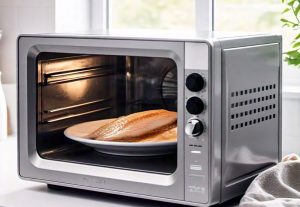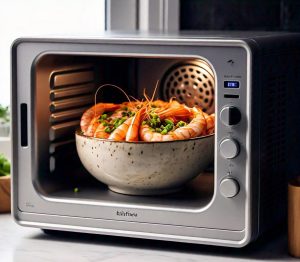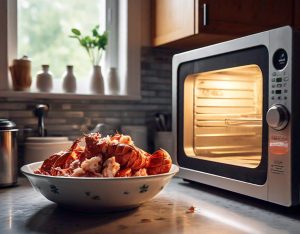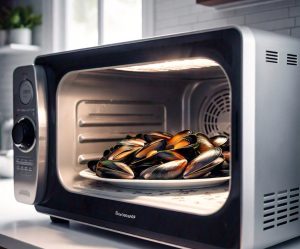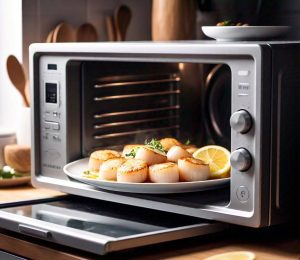Wondering if you can microwave fish without it turning into a rubbery disaster? The answer is a surprising yes, and we’re here to show you how.
It all comes down to using the right techniques to keep seafood moist and flavorful.
We cover everything from perfect fish fillets to reviving leftover lobster.
Jump To:
Unlocking the Secrets to Perfect Microwave Fish Fillets
From my own experience, microwaving fish fillets is one of the most underrated cooking methods. The key lies in creating steam pockets that keep the fish incredibly moist.
What I found works best is placing the fillet on a microwave-safe plate and adding just 2-3 tablespoons of water or white wine. Cover tightly with microwave-safe plastic wrap, leaving one corner slightly vented.
We cook thin fillets for 2-3 minutes and thicker pieces for 4-5 minutes on high power. The fish should flake easily with a fork when done.
One mistake I made early on was overcooking. Fish continues cooking from residual heat, so we always err on the side of slightly underdone. You can always add 30 seconds more if needed.
For best results, we arrange fillets in a single layer with thicker portions toward the outside of the plate. This ensures even cooking throughout.
Mastering the Art Of Microwaving Shrimp for Quick Meals
Microwaving shrimp has become our go-to method for quick weeknight dinners. The secret is understanding that shrimp cook incredibly fast and become rubbery when overdone.
What I strongly suggest is arranging shrimp in a circle around the edge of your microwave-safe dish. This creates the most even heating pattern we’ve found.
For medium-sized shrimp, we microwave for 1-2 minutes on high power. Large shrimp need 2-3 minutes max. The shrimp are done when they turn pink and curl into a loose C-shape.
From my own trials, adding a tablespoon of butter or olive oil prevents the shrimp from drying out. A squeeze of lemon juice after cooking brightens the flavor remarkably.
One technique that works brilliantly is covering the dish with a damp paper towel. This creates gentle steam that keeps the shrimp tender and juicy.
Reviving Leftover Lobster to Perfection in Your Microwave
Reheating lobster requires a delicate touch to avoid turning expensive shellfish into expensive rubber. We’ve learned this the hard way after ruining a few beautiful lobster tails.
What I found works best is wrapping lobster meat in damp paper towels before microwaving. This creates a gentle steam environment that prevents overcooking.
For lobster tail meat, we use 30-second intervals on medium power (50%). Check after each interval and stop as soon as the meat feels warm throughout.
One mistake I made was using high power, which made the lobster tough and chewy. Low and slow is the only way we reheat lobster now.
If you’re reheating whole lobster pieces, place them in a microwave-safe dish with a tablespoon of water. Cover tightly and heat for 1-2 minutes maximum.
From my own experience, adding a pat of butter before reheating helps maintain the lobster’s rich, succulent texture.
Also See: Lazy Microwave Frozen Chicken Patty With Instant Rice
Steaming Mussels Quickly and Safely Using Microwave Power
From my own experience, microwaving mussels creates the perfect steaming environment without the hassle of a large pot. The key is working with the mussels’ natural moisture to create intense steam.
What I found works best is arranging cleaned mussels in a single layer in a microwave-safe dish. We add just 2-3 tablespoons of white wine or water, then cover tightly with microwave-safe plastic wrap.
For one pound of mussels, we microwave on high power for 3-4 minutes. The shells should pop open when they’re done – any that remain closed after cooking should be discarded.
One mistake I made early on was overcrowding the dish. This creates uneven heating and some mussels cook while others barely warm up. We always use a large enough dish now.
From my own trials, piercing any mussels that seem tightly closed before cooking prevents them from exploding. The steam builds up incredibly fast in the microwave.
Achieving Tender Scallops With Simple Microwave Techniques
Microwaving scallops requires a gentle touch since they cook remarkably fast. What I strongly suggest is patting them completely dry first – excess moisture creates uneven heating.
From my own experience, arranging large sea scallops in a circle around the edge of a microwave-safe plate works brilliantly. We add a tablespoon of butter and a splash of white wine for flavor.
For jumbo scallops, we cook for 2-3 minutes on medium-high power (80%). Smaller bay scallops need just 1-2 minutes. They should be opaque throughout when done.
One technique that works perfectly is covering the dish with a microwave-safe lid or vented plastic wrap. This creates gentle, even heat that prevents the scallops from becoming rubbery.
What I found prevents overcooking is letting them rest for 30 seconds after microwaving. They continue cooking from residual heat, reaching the perfect tender texture.
Essential Tips for Microwaving Frozen Seafood
Defrosting frozen seafood properly makes all the difference between tender, flaky fish and tough, chewy disappointment. From my own trials, we’ve learned patience is absolutely critical here.
What I strongly recommend is using the defrost setting (30% power) rather than full power. This prevents the outer edges from cooking while the center remains frozen solid.
For frozen fish fillets, we defrost for 3-4 minutes per pound, flipping halfway through. The fish should feel pliable but still slightly icy in the thickest parts.
One mistake I made was trying to cook frozen seafood directly without defrosting. This creates incredibly uneven results – overcooked edges and raw centers that no amount of additional cooking can fix.
From my own experience, placing frozen seafood on a microwave-safe rack or inverted plate helps. This allows melted ice to drain away instead of creating a water bath that partially steams the seafood.
What works best for frozen shrimp is defrosting in 1-minute intervals, rearranging each time. They defrost much faster than fish and can go from frozen to overcooked in seconds.
After defrosting, we always pat the seafood completely dry before cooking. This removes excess moisture that would otherwise create steam and prevent proper browning or searing.
Understanding Microwave Safety for All Types Of Seafood
Microwave safety with seafood isn’t just about preventing foodborne illness – it’s about preserving the delicate texture and flavor that makes seafood so special. From my own experience, a few key safety principles make all the difference.
What I found most important is using proper temperature guidelines. We always ensure seafood reaches an internal temperature of 145°F (63°C) for fish and 165°F (74°C) for shellfish like lobster and crab.
From my own trials, investing in a reliable instant-read thermometer changed everything. Guessing doneness by appearance alone led to overcooked disasters or, worse, undercooked seafood that posed health risks.
One mistake I made early on was not accounting for carryover cooking. Seafood continues cooking from residual heat after microwaving, so we always stop slightly before the target temperature.
What I strongly suggest is arranging seafood pieces with uniform thickness. This prevents hot spots that can harbor bacteria while other areas remain undercooked. We rearrange pieces halfway through cooking for even heat distribution.
From my own experience, covering seafood during microwaving isn’t just about moisture – it creates more consistent heating patterns. We use microwave-safe lids or vented plastic wrap to trap steam while allowing pressure to escape.
Defrosting safety deserves special attention since improperly thawed seafood breeds harmful bacteria rapidly. We never use warm water or leave seafood at room temperature to thaw.
What works best is using the microwave’s defrost setting at 30% power. This prevents creating warm zones where bacteria multiply while the center remains frozen solid.
One critical safety rule I learned is the two-hour window. Once seafood reaches room temperature, bacteria multiply exponentially. We either cook it immediately or refrigerate it again within two hours maximum.
From my own trials, testing multiple spots with a thermometer ensures thorough cooking. Thick pieces like lobster tails or large fish fillets can have significant temperature variations throughout.
What I found prevents cross-contamination is using separate plates for raw and cooked seafood. We also wash our hands thoroughly after handling raw seafood and before touching anything else in the kitchen.
Ready to Transform Your Seafood Cooking Game?
We’ve covered the essential techniques that will revolutionize how you prepare seafood in your microwave. From perfectly flaky fish fillets in under 4 minutes to tender scallops that rival restaurant quality, these methods prove that microwave cooking isn’t just convenient-it’s a legitimate culinary technique. The key lies in understanding timing, power levels, and proper moisture retention.
Start with one technique that excites you most, whether it’s the 90-second shrimp method or the steam-pouch technique for mussels. Remember to use your microwave’s 70% power setting for most seafood and always check for that internal temperature of 145°F. Your weeknight dinners will never be the same once you master these quick, foolproof methods that deliver restaurant-quality results right from your kitchen counter.

